![]()
![]()
![]()
Use LEFT and RIGHT arrow keys to navigate between flashcards;
Use UP and DOWN arrow keys to flip the card;
H to show hint;
A reads text to speech;
85 Cards in this Set
- Front
- Back
|
What is a nucleic acid? |
-macromolecule composed of chains of monomeric nucleotides -located w/in cells and form structures |
|
|
what is the basic unit of nucleic acid? |
NUCLEOTIDE |
|
|
Nucleic acid are based on what? And what two categories do Nucleic Acid fall in? |
-Based on diff. pentose sugars & nitrogenous base -1.) DNA Deoxyribonucleic acid 2.) RNA ribonucleic acid |
|
|
What is DNA? |
the genetic material that has all the info. to direct every cellular process is carried w/in DNA |
|
|
What is RNA? |
participate in several cellular processes involved in the formation transfer from the DNA to protein synthesis. -the info. in DNA & RNA is encoded in the order of bases |
|
|
Nucleic acid are based on functions, RNA falls into 3 categories which are? |
1.) mRNA 2.) rRNA 3.) tRNA |
|
|
What is mRNA, rRNA & tRNA? |
-mRNA: template of DNA, carries info from DNA to ribosomes -rRNA: protein manufacturer -tRNA: rRNA & tRNA are involved in protein synthesis (transport genetic code) |
|
|
Nucleic acid are composed in three parts name them? |
1.) Nitrogenous base: aromatic ring of Carbon & nitrogen 2.) Pentose Sugar: 5 carbon sugar in ring form 3.) Phosphate group: acidic in nature |
|
|
nitrogenouse base, pentose sugar & phosphate group make what? |
nucleotide |
|
|
Nitrogenous bases are in two categories which are? |
1.) Purine 2.) Pyrimidine
|
|
|
What is a purine? |
-fused 5-6 member ring -AG (adenine & guanine) |
|
|
What is pyrimidine? |
-6 member ring - C, U, T (cytosine, uracil, thymine)
|
|
|
What is the difference btw Thymine and Uracil? |
-There is a METHYL group at C5 on Thymine, which uracil does not. |
|
|
what are the two sugars? |
Ribose & 2-deoxyribose -2-Deoxoyrbions has no OH on C2' |
|
|
What are phosphate groups? |
-phosphorous occur mainly in the form of acidic phosphate groups, they are always negatively charged -DNA & RNA are neg. charged cuz Phosphate is negatively charged. |
|
|
Nitrogenous bases is linked to what? |
1 ' carbon of sugar
|
|
|
Nucleoside includes what parts? |
Nitrgoenous base + sugar -glycosidic bond from N1 to pyrimidines or N9 of purines |
|
|
Phosphate groups is attached to what? |
5 ' carbon of sugar
|
|
|
Nucleotide include what parts? |
nitrogenous base + sugar + phosphate |
|
|
DNA is a long molecule made up of what? |
polynucleotide |
|
|
one nucleotide has three parts which are? |
nitrogenous base + pentose sugar (2'-deoxyribose) + phosphate grp |
|
|
DNA molecule contains 4 nitrogenous bases which are ? |
A, T, C, G |
|
|
What is the DNA structure? |
-a polymer of nucleotides w/a long, flexible, threadlike structures -constant diameter w/regulary spaced & repeated structures -phosphodiester bonds link 5 ' phosphate of one nucleotide to the 3 ' OH of another
|
|
|
DNA is usually what? |
-two single-stranded nucleic acids held together by base pairing through hydrogen bonds in anti-parallell orientation called double stranded, the DNA DOUBLE HELIX |
|
|
What forms the backbones of the DNA structure? |
-sugar & phosphate residues in each strand |
|
|
How does the backbone of the DNA structure run? |
-run anti-parallel (in opposite directions) to each in the 5' to 3' |
|
|
The two strands of the double helix are held together by what? |
base paring in anti-parallel orientation |
|
|
1.) A : T are held together by what? 2.) C : G are held together by what? |
1.) 2 hydrogen bonds 2.) 3 hydrogen bonds |
|
|
The two chains of double helix have what? |
-complementary sequences that goes 5' to 3' (on one chain) & 3' to 5" (opposite chain) |
|
|
What is the fundamental feature of the double helix? |
hydrogen bonds btw the complementary bases |
|
|
Double helix has 2 external grooves called what? |
major and minor grooves
|
|
|
What is a groove? |
the space btw the strands |
|
|
Each complete twist of DNA is how long in length? |
3.4 nm |
|
|
The major groove is _____ wider than the minor groove and rich in what? |
50% ; chemical info. |
|
|
The sugar-phosphate backbone circles around where? |
outer surface of DNA |
|
|
DNA is usually right-handed double helix or left handed helix? |
Right handed double helix |
|
|
Left handed double helix is only what? |
alterative purine & pyrimidine |
|
|
DNA structure image of right-handed vs left-handed doubles helix. Look at image! |
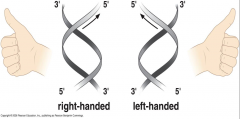
|
|
|
Double helix has 3 forms which are? |
1.) B DNA right handed (flower) 2.) A DNA right handed (donut) 3.) Z DNA left handed (ball) |
|
|
Look at the pic of the 3 forms of DNA double helix. |
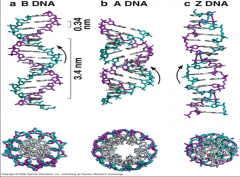
|
|
|
which one is the most common double helical structure? |
- B DNA
|
|
|
What is the B form DNA? |
-observed at high humidity -vast majority of the DNA in the cell = B form -right-handed - ~ 10 nucleotides per turn -contains a major & minor groove -Major groove is wider than minor groove |
|
|
What is A form of DNA? |
-observed under low humidity -observed in certain DNA-protein complexes, RNA- DNA and RNA-RNA helices. -right handed - ~ 11 nucleotides per turn -contains a major & minor groove -Major groove is narrower, much deeper than B form -minor groove is broader & shallower
|
|
|
What is the Z form of DNA? |
-observed in DNA containing alterative purine & pyrimidine -left handed -helix w/ zigzag look
|
|
|
DNA double helix can separate which is called, define it? |
Denature/ DNA melting -heat to near 100 C -High PH |
|
|
DNA double helix can reassociate is called, define it? |
renature -single strands often meet their complementary strands & reform regular double helixes when heated solution of denatured DNA are slowly cooled. |
|
|
What is hybridization? |
-artificial hybrid DNA to be formed by slowly cooling mixtures of denatured DNA from 2 diff. Sources. (the basis of several molecular techniques) |
|
|
(Denature of DNA ) -when DNA is heated to 80 degrees and up, its UV absorbance is what and increases to what? |
260 nm ; 30-40% |
|
|
(DENATURE of DNA) The hyper chromic shift reflects on what? |
the unwinding of the DNA double helix |
|
|
(denature of DNA) When temperature is lowered, the ______ drops, reflecting the ___________. |
absorbance ; re-estabilishment of stacking |
|
|
(Denature of DNA) What is Tm? |
melting temperature: a point which exactly half of a double stranded sequence becomes single-stranded. |
|
|
What is DNA supercoiling structure? |
-occurs in closed structure when ends are not free to release torsion on molecule -in duplex, DNA 10 bp per turn of helix, circular DNA sometimes has more or less than 10 bp per turn.
|
|
|
What are topoisomerase or gyrases? |
-removes supercoils |
|
|
DNA has type types of supercoiling which are? |
1.) positive supercoiling 2.) negative supercoiling |
|
|
What is positive supercoiling? |
- when DNA is supercoiled in the same direction as the intrinsic winding of helix -tightens the structure -increase the rotation per base pair -overwound
|
|
|
DNA is said to be overwound is called? DNA is said to be underwound is called? |
-Positive supercoiling -negative supercoiling
|
|
|
Microorganisms that lived under high extreme high temps such as hot springs have what kinda of supercoiled DNA? |
-positive supercoiled DNA
|
|
|
what is DNA negative supercoiling? |
-twists dada about its axis in the opposite direction rom the clockwise turn of the right-handed double helix -loosens the winding of the 2 strands -reduces the rotation per base pair
|
|
|
Circular DNA from bacterial and eukaryotes are usually what type of supercoiling? |
-negative supercoiling |
|
|
look at the structures of DNA supercoiling? |
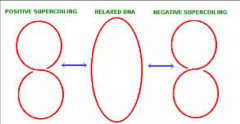
|
|
|
DNA supercoiling requires what? |
-energy to introduce supercoil and to separate DNA strands for replication or transcription -does not occur spontaenously
|
|
|
Molecules without supercoiling is said to be what? |
relaxed |
|
|
DNA supercoiling is important for what? and required for what? |
-DNA packaging w/in the cell -DNA/RNA synthesis |
|
|
Supercoils results as.... |
result of the undwinding of DNA for DNA/RNA polymerase action -Topoisomerases |
|
|
DNA supercoiling structure can be separated by what technique? |
-gel electrophoreiss - the more compact the Dna, the fasted it is able to migrate through the gel |
|
|
what is topoisomerase? |
-enzyme that catalyzes the reversible breaking and rejoining of DNA strands (relieves the strain of twisting) -maintains supercoling by acting as a swivel |
|
|
what are the two types of topoiosomerase? |
1.) Type 1: make transient single-strand breaks (NO ATP)
2.) Type 2: make transient double-strand breaks ( REQUIRE ATP) |
|
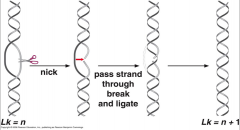
what topoisomerase type is this? |
Type 1 |
|
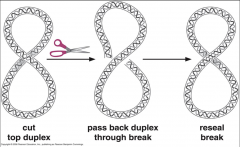
what topisomerase type is this? |
type 2 |
|
|
What is RNA? |
-long molecule made up of polynucleotide -single stranded - nucleotide w/ 3 parts - 4 nitrogen bases: A, U, G, C -contains 10 times more RNA than DNA -URACIL in place of THYMINE
|
|
|
RNA has 3 primary classes which are? |
1.) rRNA- 3-4 different types 2.) tRNA - 50 different types 3.) mRNA - > 1000 different types |
|
|
For RNA, a nucleotide contains what? |
nitrogenous base sugar (RIBOSE) phoshpate group |
|
|
RNA chains fold back on themselves to form diff. structures what are they? |
a. hairpin b. bulge c. Loop |
|

label these. |
a. hairpin b. bulge c. loop -Theses are stem-loop structures |
|
|
what is a stem-loop structure? |
non complementary sequences become "looped out" to form different structure. |
|
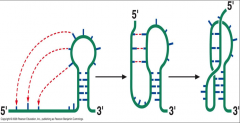
what is this? |
pseudoknot |
|
|
what is a psedoknot? |
formed by base pairing take place btw noncontiguous complementary sequences |
|
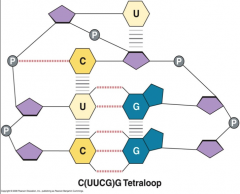
what is this? |
C(UUCGG)G TETRALOOP |
|
|
what is a C(UUCG)G TETRALOOP? |
SPECIAL bise stacking interactions in the loops |
|
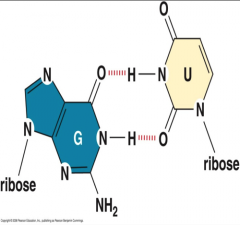
what is this? |
tertiary structure G : U |
|
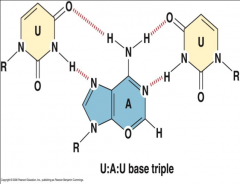
what is this? |
tertiary structure, U : A : U base triple |
|
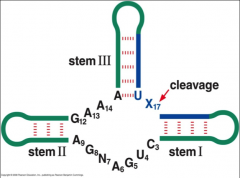
what is this? |
-secondary structure, enzyme -Hammer head ribozyme |
|
|
What does hammer head ribozyme do? |
cleavesRNA by the formation of 2', 3' cyclic phosphate |
|
|
Some RNA's can be what? |
enzymes (RIBOZYMES) ex: RNase P & RNA Self-splicing |
|
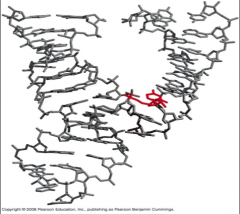
what is this? |
tertiary strcture |

